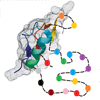Tag Archives:protein
Participation of secreted protein L5 in formation of outer membrane vesicles produced by Lysobacter sp. XL1
A Tat ménage a trois – when it comes to Tat secretion two Tat’s are essential, but the third one makes it that much better
Can we create easy-to-use software to capture the complex behaviors of proteins?
How do microorganisms survive in extreme conditions?
You may have taught how extreme regions like glaciers, mountains, and deep oceans are habitats for many organisms including bacteria, archaea, algae, and yeasts as well as glaciers ice worms, plants and animals. These organisms survive in
Predictors of 360-day survival in centenarians
Healthy aging assumes the combination of longevity and quality of life. Quality of life in old age is associated with mental and physical well-being allowing for independent living and social function. Appropriate scales can be used to
Cold denaturation
Why do older people get so much kidney disease?
To celebrate Sir William Osler’s 70th Birthday on July 12th 1919 his pupils and co-workers contributed scientific articles that were collected and published. One of these articles, by William Councilman pathologist-in-chief at Peter Bent Brigham Hospital, noted




















